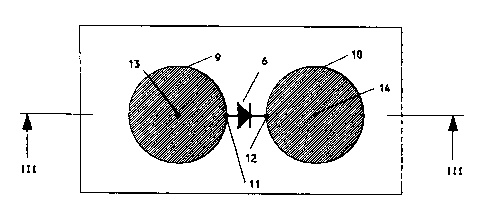Some of the information on this Web page has been provided by external sources. The Government of Canada is not responsible for the accuracy, reliability or currency of the information supplied by external sources. Users wishing to rely upon this information should consult directly with the source of the information. Content provided by external sources is not subject to official languages, privacy and accessibility requirements.
Any discrepancies in the text and image of the Claims and Abstract are due to differing posting times. Text of the Claims and Abstract are posted:
| (12) Patent: | (11) CA 2147196 |
|---|---|
| (54) English Title: | MICROWAVE INTEGRATED TUNED DETECTOR |
| (54) French Title: | DETECTEUR HYPERFREQUENCE ACCORDE |
| Status: | Expired and beyond the Period of Reversal |
| (51) International Patent Classification (IPC): |
|
|---|---|
| (72) Inventors : |
|
| (73) Owners : |
|
| (71) Applicants : |
|
| (74) Agent: | MARKS & CLERK |
| (74) Associate agent: | |
| (45) Issued: | 2002-11-19 |
| (22) Filed Date: | 1995-04-18 |
| (41) Open to Public Inspection: | 1995-11-10 |
| Examination requested: | 2002-03-19 |
| Availability of licence: | N/A |
| Dedicated to the Public: | N/A |
| (25) Language of filing: | English |
| Patent Cooperation Treaty (PCT): | No |
|---|
| (30) Application Priority Data: | ||||||
|---|---|---|---|---|---|---|
|
A microwave detector, which integrates two circular
patch antennas with a detector diode. The high impedance
at the edge of the circular patch antenna is combined
with 180° out of phase electric fields at diametrically
opposite points, so as to match to the RF impedance of a
zero or small DC bias diode. The result is a very
simple, high-sensitivity narrow-band microwave integrated
detector.
Note: Claims are shown in the official language in which they were submitted.
Note: Descriptions are shown in the official language in which they were submitted.

2024-08-01:As part of the Next Generation Patents (NGP) transition, the Canadian Patents Database (CPD) now contains a more detailed Event History, which replicates the Event Log of our new back-office solution.
Please note that "Inactive:" events refers to events no longer in use in our new back-office solution.
For a clearer understanding of the status of the application/patent presented on this page, the site Disclaimer , as well as the definitions for Patent , Event History , Maintenance Fee and Payment History should be consulted.
| Description | Date |
|---|---|
| Time Limit for Reversal Expired | 2008-04-18 |
| Inactive: Adhoc Request Documented | 2007-06-13 |
| Letter Sent | 2007-04-18 |
| Inactive: IPC from MCD | 2006-03-11 |
| Inactive: IPC from MCD | 2006-03-11 |
| Grant by Issuance | 2002-11-19 |
| Inactive: Cover page published | 2002-11-18 |
| Inactive: Final fee received | 2002-09-05 |
| Pre-grant | 2002-09-05 |
| Letter Sent | 2002-05-23 |
| Notice of Allowance is Issued | 2002-05-23 |
| Notice of Allowance is Issued | 2002-05-23 |
| Inactive: Approved for allowance (AFA) | 2002-05-15 |
| Letter Sent | 2002-04-15 |
| Inactive: Status info is complete as of Log entry date | 2002-04-15 |
| Inactive: Application prosecuted on TS as of Log entry date | 2002-04-15 |
| All Requirements for Examination Determined Compliant | 2002-03-19 |
| Request for Examination Requirements Determined Compliant | 2002-03-19 |
| Application Published (Open to Public Inspection) | 1995-11-10 |
There is no abandonment history.
The last payment was received on 2002-02-14
Note : If the full payment has not been received on or before the date indicated, a further fee may be required which may be one of the following
Please refer to the CIPO Patent Fees web page to see all current fee amounts.
| Fee Type | Anniversary Year | Due Date | Paid Date |
|---|---|---|---|
| MF (application, 3rd anniv.) - standard | 03 | 1998-04-20 | 1998-02-19 |
| MF (application, 4th anniv.) - standard | 04 | 1999-04-19 | 1999-03-08 |
| MF (application, 5th anniv.) - standard | 05 | 2000-04-18 | 2000-03-28 |
| MF (application, 6th anniv.) - standard | 06 | 2001-04-18 | 2001-03-30 |
| MF (application, 7th anniv.) - standard | 07 | 2002-04-18 | 2002-02-14 |
| Request for examination - standard | 2002-03-19 | ||
| Final fee - standard | 2002-09-05 | ||
| MF (patent, 8th anniv.) - standard | 2003-04-22 | 2003-04-22 | |
| MF (patent, 9th anniv.) - standard | 2004-04-19 | 2004-04-15 | |
| MF (patent, 10th anniv.) - standard | 2005-04-18 | 2005-03-30 | |
| MF (patent, 11th anniv.) - standard | 2006-04-18 | 2006-04-04 |
Note: Records showing the ownership history in alphabetical order.
| Current Owners on Record |
|---|
| KASTEN CHASE APPLIED RESEARCH LIMITED |
| Past Owners on Record |
|---|
| ALEXANDRU OPREA |